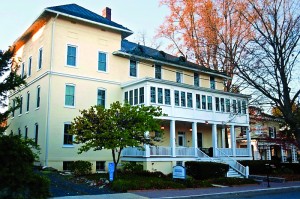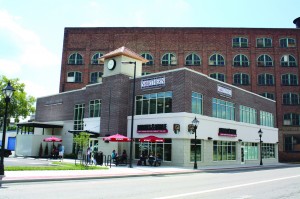By Michael Mills
Green preservation expert Carl Elefante has been credited with the saying, “The greenest building is the one that is already built.” Although sustainability has become a fast-growing trend, reusing old buildings is not a new concept. For hundreds of years, old buildings have found new purposes through adaptive reuse for economic, social and, more recently, environmental reasons. In West Virginia, creative architects, contractors and individuals are changing the landscape by reusing historic buildings and breathing new life into communities.

Etter Hall, American Public University System
Etter Hall, American Public University SystemPreservation of historic buildings doesn’t have to include putting a proverbial glass box over a structure in order to protect it. Buildings are best preserved when they are continually used and appreciated. Some people believe buildings are not useful once the original purpose no longer exists or when the mechanical systems do not meet current codes, meaning the only option is to tear the building down. While demolition will still occur sometimes, the best option is often restructuring.
Adaptive reuse makes economic sense. Federal and state incentives, which include grants and historic rehabilitation tax credits, encourage the reuse of existing buildings. Rehabilitated historic buildings can also serve as a catalyst for other economic development including heritage tourism and the creation of local construction jobs. As Jane Jacobs wrote in her landmark book, “The Death and Life of Great American Cities,” new entrepreneurs need old buildings. Today, preservation expert Donovan Rypkema emphasizes that historic buildings are the ideal size for incubating new businesses. They are affordable and provide dynamic spaces for creative individuals. Preservation efforts also attract heritage tourists who travel and spend their money on local establishments, reinforcing the idea that there are significant economic benefits of renovating and reusing historic structures.
Reusing existing buildings also promotes sustainable lifestyles. Each structure that is reused prevents greenspace, like parks, from being developed into commercial or residential property. The old growth wood and timber used in many early buildings also provides more strength and durability than new timber. Modern construction materials are oftentimes imported from overseas, adding to the cost and increasing the carbon footprint of the project. By reusing older buildings, much of the expense goes toward the labor source, which spends money locally. Additionally, the integrity of older buildings cannot be replicated due to the skilled, old-world craftsmanship that is no longer part of our modern construction trades.
Each generation of buildings tells a story about what life was like in our communities. Historic structures and neighborhoods oftentimes provide a sense of place, give a location a reason for being and create gathering spaces where residents can socialize and congregate. Modern strip malls and big box stores are generic to the nation, and communities can get lost without the anchor of their past.
While the benefits of adaptive reuse are many, there are some challenges to overcome while reusing vacant spaces. Many industrial sites may be considered brownfields, where potentially hazardous materials may have contaminated the site. Other issues may be programmatic, in that developers need to be creative in finding innovative solutions to constraints or there are unknowns hidden behind the walls. While these challenges exist, West Virginia is fortunate to possess a number of talented individuals who are easily accessible to help guide potential projects to successful completion.

West Virginia Northern Community College Student Union
In Wheeling, Vic Greco with SMG Architects designed a new use for two buildings that were originally part of the former Straub Honda dealership. Now serving as the Applied Technology Center and Student Union for West Virginia Northern Community College (WVNCC), these formerly vacant buildings were located across the street from West Virginia’s Independence Hall and now seamlessly blend into the community. This project was an example of a context-sensitive solution that elevated the neighborhood and augmented the former B&O railroad station that had previously been reused for WVNCC.
The most successful repurposing projects take full advantage of the superior materials and craftsmanship used in the original building. AU Associates, a development firm from Lexington, KY, has been very successful in capturing the quality of older buildings in their efforts throughout West Virginia. AU has most recently retrofitted two educational institutions for use as senior housing. The Clendenin School in Kanawha County and the First Ward School in Elkins were successful redevelopment projects that fulfilled a key community need while preserving and reusing vacant, abandoned schools. AU retained the original heart pine floors, the open hallways and the numerous windows that flood each new apartment with natural light. AU also capitalized on state and federal grant funding and historic rehabilitation tax credits to enable this project to become a reality.

The Morgantown History Museum and Morgantown Arts Center
Even buildings like old post offices can find new uses. The Morgantown History Museum recently relocated into the former Morgantown Post Office’s lower level. When the museum outgrew its original location in a neighboring building, they asked the Mills Group of Morgantown to design a space that would allow them to showcase their local history collection while creating an environment flexible for traveling exhibits and classes. This Beaux Arts-style building now serves two distinct cultural entities with the museum on the lower level and the Monongalia Arts Center (MAC) on the main level. The MAC utilizes the space by hosting exhibits, small concerts and numerous classes. This collaboration creates an economy of scale and a destination for residents and travelers alike.
Higher educational facilities are oftentimes known for constructing new buildings to fit their needs, but American Public University System (APUS) in Charles Town saw the potential in reusing existing buildings for their extended downtown campus. As part of their comprehensive plan, APUS made a conscious effort to maintain the historic character of their buildings while increasing their energy efficiency. Efforts include installing a high energy efficiency HVAC system, motion sensor lighting and low-flow toilets. APUS’s examples show how historic buildings can be retrofitted for modern, sustainable technology.
Several West Virginia-based contracting firms have been instrumental in transforming historic buildings. Allegheny Restoration, based in Morgantown, is a contracting company that has been restoring wood windows and doors for more than 25 years. Past Respects, based in Spencer, WV, is an expert in material conservation. Both companies recognize the value in preserving existing buildings and materials for reuse.
Numerous organizations are working to help redevelop historic properties throughout the state. Preservation Alliance of West Virginia (PAWV) is a statewide nonprofit organization dedicated to the preservation of West Virginia’s heritage. This organization can help individuals and developers learn the benefits of reusing existing buildings, raising awareness and finding funding. Lynn Stasick, the statewide field representative of PAWV, has also made it his mission to empower individuals and homeowners through learning about the benefits of existing wood windows and teaching them how to correctly repair windows themselves.
The North Central West Virginia Brownfields Association provides technical assistance and funding for the identification and reuse of potentially hazardous sites, and the State Historic Preservation Office (SHPO) is a source of technical and funding assistance for the redevelopment of historic buildings. The SHPO provides planning and development grants and also oversees the historic rehabilitation tax credit program in conjunction with the National Park Service.
Adaptive reuse is not only a smart economic, social and environmental philosophy and policy, but it’s also about preserving West Virginia’s communities and legacy one building at a time.




1 Comment
Thank you Mr. Mills.
It’s about time West Virginia takes a stand against the destruction of our industrial age buildings, badges of our former industrial might, and do it in a low-impact, cost-effective and long-term way.
Please write more about this subject!